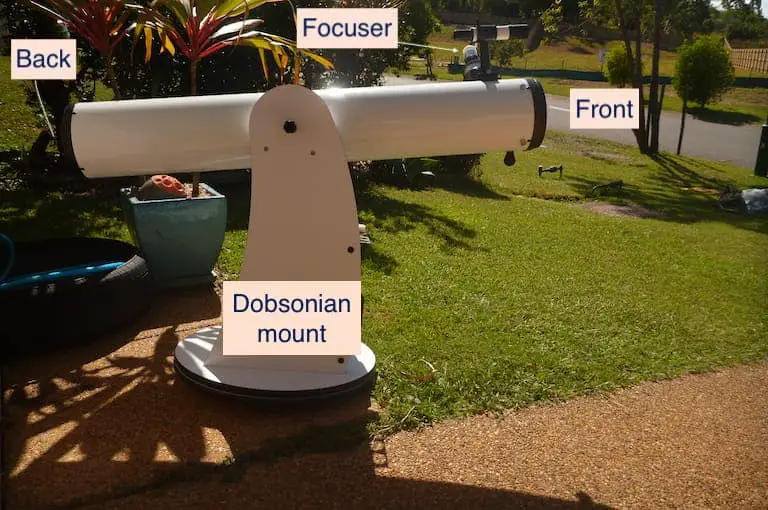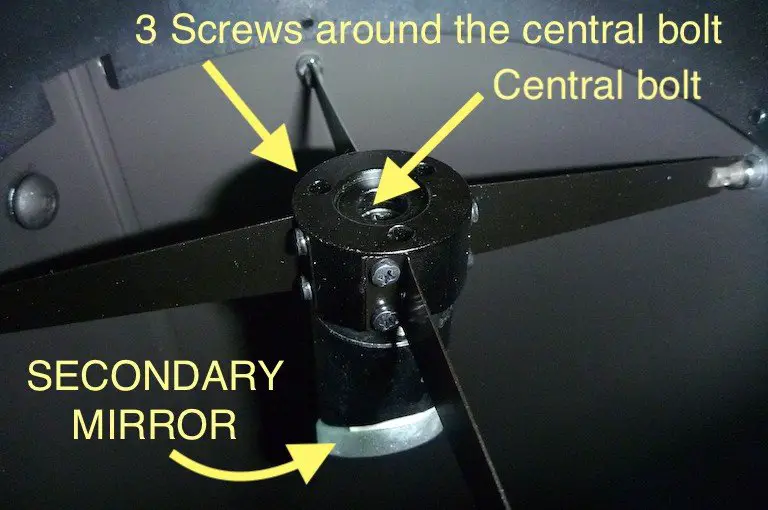If you’ve got a Dobsonian, you’ll need to collimate it. How do you do that? It may seem offputting. But, once you get the hang of it, it’s painless and should only take you a few minutes. The following takes you through the steps with illustrations to help you learn how to collimate a Dobsonian telescope.
You already know the advantages and disadvantages of a Dobsonian telescope. Here, I aim to help you with what seems a tricky maintenance routine of collimation. This maintains your Dob for a satisfying experience.
Instructions that come with the telescopes may summarize how to do the collimation, but these are often too generalized or hard to understand.
The benefit of a written format like this is that you don’t have to refer to a video each time you need to collimate your telescope. You can simply read the step-by-step instructions on your mobile device or print them out so you have them with the telescope for when it needs collimation.
It’s one of those accessories to get for the Dobsonian — a collimation tool. Options include…
- A collimation cap (also called a sight tube),
- Cheshire, or
- Laser collimator
Outline: How to collimate a Dobsonian telescope use a collimation cap
The following are detailed instructions on how to collimate a Dobsonian. It is a step-by-step quick reference guide for using a collimation cap:
- Confirm your telescope needs collimating. You can use the ‘out-of-focus star method’. If the ‘Airy disc’ is off-center, it needs collimation. Take note of the side closest to this center circle of light – you will need to adjust the mirrors on this side.
- Get your DIY or store-bought collimation cap (AKA a sight tube).
- Take off the large lens cap on the front of the telescope.
- Using the collimation cap in place of an eyepiece look through the focuser for the 3 clips of the larger primary mirror at the back.
- Align the secondary mirror, alternating adjustment of the screws on top of the mirror holder until you see the 3 clips.
- Check out the larger primary mirror at the back. Align this using its 3 adjusting screws at the base.
- Test again using the out-of-focus star method to see if the collimation is now correct.
- If not, tweak it by repeating the process.
When doing the adjustments, it helps to have an offsider looking through the focus while you do the adjustment (or vice versa).
How to collimate a reflector telescope is much the same as collimating a Dob. After all, a Dob is a reflector.
How do I know if I need to collimate my telescope?
To confirm know whether or not your telescope needs collimating, there is a simple test using out-of-focus star images, which is also referred to as the star test for telescopes.
You might know when your telescope needs collimating…because no matter what you do you can’t get a clear image. The Moon’s craters are blurred and Saturn’s rings look like handles.
Star testing a Dobsonian for collimation
There are 3 steps to the method of using out-of-focus star images…
- On a dark night, position your telescope so that a bright star is in the center of the field of view.
- Now, adjust the focuser so what you see is slightly out of focus. You should see a central circle of light (the Airy disc) with many diffraction (Fresnel) rings around it.
- Check to see if the rings are symmetrical around this central circle of light. If not, e.g. they lean to one side, your telescope needs collimation.
You might find that the best magnification for star testing, at least, to begin with, is 25x for each inch of aperture. As examples, for a 6-inch, the magnification would be 6 x 25 (150x) and for an 8-inch Dobsonian, 8 x 25 (200x).
You could then fine-tune up to 50x per inch (300x for 6-inch and 400x for 8-inch — about the maximum limit), where viewing conditions permit.
What is the primary mirror of a telescope vs the secondary?
Reflectors, like the Dobsonian, have two mirrors. The secondary mirror is the smaller oval-shaped one at the top of the telescope tube that is angled toward the focuser. The primary mirror is the larger mirror at the back of the tube. It captures the light and sends it back to the angled secondary mirror at the front that then reflects it through the focuser.
This all makes sense, but let’s face it, not all telescopes are the same and it can be confusing when you’re new to using astronomy telescopes.
It is good to know which is which and to get familiar with your telescope design early in the piece to avoid confusion and possible errors when trying to collimate.

Detailed instructions: aligning your secondary and primary mirrors
The mirror cells will have adjusting collimation screws. The collimation described next uses a collimation cap and starts with the secondary mirror.
Secondary mirror at front
Have a look at the secondary mirror. It is held in a support with a central bolt behind it. This larger screw moves the mirror up and down.
Around the central bolt are three screws. These screws adjust the mirror’s angle – normally 45º towards the focuser. You will use these alternately to adjust and align the secondary mirror with the primary mirror.
How to align the secondary mirror
First, point the telescope at the wall that’s well lit.
Using the collimation cap in place of an eyepiece, look through the focuser for the 3 clips of the larger primary mirror, inside, at the back of the telescope tube.
Turn the focus knob until you see the base of the tube, i.e. the focuser is not in the reflected image.
While disregarding the reflected image of the collimation cap (or your eye), look for the 3 clips.
If you can’t see the three clips, alternate the adjustment of the three screws on top of the secondary mirror holder (see image above) until you do. When you loosen one, tighten the others to compensate for the slack.
Once successful, tighten all three screws to ensure the secondary mirror is secure.
Primary mirror at back
Now check out the primary mirror. It is held in place by screws that are spaced apart (about 120º apart for a 6-inch Dob) at the back of the tube. It is these that you’ll adjust for the primary mirror.
How to align the primary mirror
You may need someone to help with the primary mirror, depending on the size of your telescope.
First, make small adjustments – loosen the three adjustment screws just a little (a few turns). If you’re not sure which ones are the adjustment screws, see the image above.
Now while looking through the collimation cap in the focuser, run your hand around the front of the telescope. The aim here to see which way the primary mirror is out of alignment using your hand’s reflected image. (A friend would be handy here)
Stop your hand at the point where the image reflected in the secondary mirror is closest to the edge of the tube (also the edge of the primary mirror).
Look at the back of the telescope and see if there is an adjusting collimation screw corresponding to that point. If so, loosen it. If not, tighten the adjusting collimation screw on the opposite side.
Whichever screw is applicable, adjust it gradually until the primary mirror is aligned, i.e. the image of your hand reflected in the secondary mirror is in the center of the view.
This is where a friend could help. Your friend could do the adjustment while you observe how well it’s aligning in the focuser or vice versa.
Retest the collimation
With good seeing conditions, take the telescope outside and with an eyepiece, perform the star test (see instructions above). If necessary tweak the alignment of the mirrors using the star as the center.
Why do you need to collimate a telescope?
You need to collimate a telescope so that the image you see is correctly orientated on the focal plane. Reflectors and SCTs require the collimation of their optics. Refractors differ in that they are factory aligned and have a fixed lens, so they rarely require collimation. Maks also tend to hold their collimation well.
A Dobsonian is a reflector telescope, it uses mirrors, a primary and a secondary, and these need to work together. They can get out of alignment through movement and with use. Hence, the reason for collimation.
I covered collimation in regard to SCT telescopes, which have a mirror and a lens. Dobsonians have only mirrors.
Collimating a Dobsonian involves aligning the mirrors so they work together to focus light to the eyepiece properly.
You’re going to get better views and hence better satisfaction with using your Dob.
Even the Hubble Space Telescope gets collimated.





